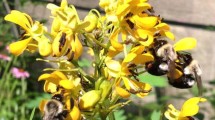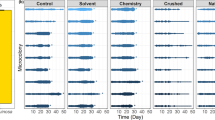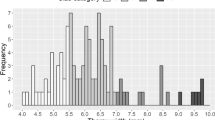Summary
Pollen-collecting bumble bees (Bombus spp.) detect differences between individual flowers in pollen availability and alter their behavior to capitalize on rewarding flowers. Specific responses by bees to increased pollen availability included: longer visits to flowers; visits to more flowers within an inflorescence, including an increased frequency of revisits; an increased likelihood of grooming while the bee flow between flowers within the inflorescence; and more protracted inter-flower flights, probably because of longer grooming bouts. The particular suite of responses that a bee adopted depended on the pollen-dispensing mechanism of the plant species involved. Bees buzzed previously-unvisited Dode-catheon flowers longer than empty flowers. In contrast, pollen availability did not significantly affect the duration of visits to Lupinus flowers, which control the amount of pollen that can be removed during a single visit. Simulation results indicate that the observed movement patterns of bumble bees on Lupinus inflorescences would return the most pollen per unit of expended energy. The increased foraging efficiency resulting from facultative responses by bees to variation in pollen availability, especially changes in the frequency and intensity of grooming, could correspondingly decrease pollen dispersal between plants.
Similar content being viewed by others
References
Buchmann SL (1983) Buzz pollination in angiosperms. In: Jones CE, Little RJ (eds) Handbook of experimental pollination biology. Van Nostrand Reinhold, New York, pp 73–113
Buchmann SL, Cane JH (1989) Bees assess pollen returns while sonicating Solanum flowers. Oecologia 81:289–294
Cane JH, Payne JA (1988) Foraging ecology of the bee Habropoda laboriosa (Hymenoptera: Anthophoridae), an oligolege of blueberries (Ericaceae: Vaccinium) in the southeastern United States. Ann Ent Soc Am 81:419–427
Cliff AD, Ord JK (1981) Spatial process. Pion, London
Dunn DB (1956) The breeding system of Lupinus, group Micranthi. Am Midl Nat 55:443–472
Ford DM, Hepburn HR, Moseley FB, Rigby RJ (1981) Displacement sensors in the honeybee pollen basket. J Insect Physiol 27:339–346
Galen C, Plowright RC (1985) Contrasting movement patterns of nectar-collecting and pollen-collecting bumble bees (Bombus terricola) on fireweed (Chamaenerion angustifolium) inflorescences. Ecol Ent 10:9–17
Gori DF (1989) Floral color change in Lupinus argenteus (Fabaceae): why should plants advertise the location of unrewarding flowers to pollinators? Evolution 43:870–881
Harder LD (1988) Choice of individual flowers by bumble bees: interaction of morphology, time and energy. Behaviour 104:60–77
Harder LD (1990) Pollen removal by bumble bees and its implications for pollen dispersal. Ecology 71:1110–1125
Harder LD, Real LA (1987) Why are bumble bees risk averse? Ecology 68:1104–1108
Harder LD, Thomson JD (1989) Evolutionary options for maximizing pollen dispersal of animal-pollinated plants. Am Nat 133:323–344
Haynes J, Mesler M (1984) Pollen foraging by bumblebees: foraging patterns and efficiency on Lupinus polyphyllus. Oecologia 61: 249–253
Heinrich B (1975) Thermoregulation in bumblebees. II. Energetics of warm-up and free flight. J Comp Physiol 96:155–166
Hodges CM, Miller RB (1981) Pollinator flight directionality and the assessment of pollen returns. Oecologia 50:376–379
Hodges CM, Wolf LL (1980) Optimal foraging in bumblebees: Why is nectar left behind in flowers? Behav Ecol Sociobiol 9:41–44
Juncosa AM, Webster BD (1989) Pollination in Lupinus nanus subsp. latifolius (Leguminosae). Amer J Bot 76:59–66
Levin DA, Berube DE (1972) Phlox and Colias: the efficiency of a pollination system. Evolution 26:242–250
Macior LW (1964) An experimental study of the floral ecology of Dodecatheon meadia. Am J Bot 51:96–108
Macior LW (1982) Plant community and pollinator dynamics in the evolution of pollination mechanisms in Pedicularis (Scrophulariaceae). In: Armstrong JA, Powell JM, Richards AJ (eds) Pollination and evolution. Royal Botanic Gardens, Sydney, Australia, pp 29–45
Michener CD, Winston ML, Jander R (1978) Pollen manipulation and related activities and structures in bees of the family Apidae. Univ Kansas Sci Bull 51:575–601
Miller RB (1978) The pollination ecology of Aquilegia elegantula and A. caerulea (Ranunculaceae) in Colorado. Am J Bot 65:406–414
Neter J, Wasserman W, Kutner MH (1985) Applied linear statistical models. 2nd ed. Irwin, Homewood, Illinois
Pellmyr O (1985) Pollination ecology of Cimicifuga arizonica (Ranunculaceae). Bot Gaz 146:404–412
Pellmyr O (1986) The pollination ecology of two nectarless Cimicifuga sp. (Ranunculaceae) in North America. Nord J Bot 6:713–723
Pellmyr O (1988) Bumble bees (Hymenoptera: Apidae) assess pollen availability in Anemonopsis macrophylla (Ranunculaceae) through floral shape. Ann Ent Soc Am 81:792–797
Percival MS (1955) The presentation of pollen in certain angiosperms and its collection by Apis mellifera. New Phyt 54:353–368
Plowright RC, Pendrel BA (1977) Larval growth in bumble bees (Hymenoptera: Apidae). Can Ent 109:967–973
Sutcliffe GH, Plowright RC (1988) The effects of food supply on adult size in the bumble bee Bombus terricola Kirby (Hymenoptera: Apidae). Can Ent 120:1051–1058
Thomson JD (1986) Pollen transport and deposition by bumble bees in Erythronium: influences of floral nectar and bee grooming. J Ecol 74:329–341
Thomson JD (1988) Effects of variation in inflorescence size and floral rewards on the visitation rates of traplining pollinators of Aralia hispida. Evol Ecol 2:65–76
Wainwright CM (1978) The floral biology and pollination ecology of two desert lupines. Bull Torrey Bot Club 105:24–38
Wolfe LM, Barrett SCH (1987) Pollinator foraging behavior and pollen collection on the floral morphs of tristylous Pontederia cordata L. Oecologia 74:347–351
Zimmerman M (1982a) Optimal foraging: random movement by pollen collecting bumblebees. Oecologia 53:394–398
Zimmerman M (1982b) The effect of nectar production on neigh-borhood size. Oecologia 52:104–108
Author information
Authors and Affiliations
Rights and permissions
About this article
Cite this article
Harder, L.D. Behavioral responses by bumble bees to variation in pollen availability. Oecologia 85, 41–47 (1990). https://doi.org/10.1007/BF00317341
Received:
Accepted:
Issue Date:
DOI: https://doi.org/10.1007/BF00317341




